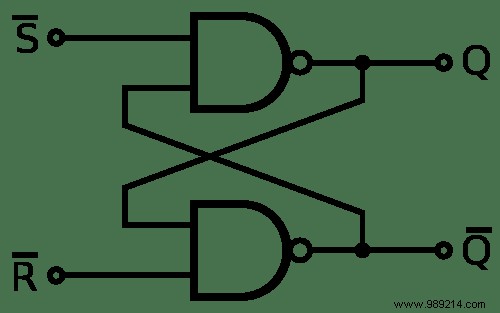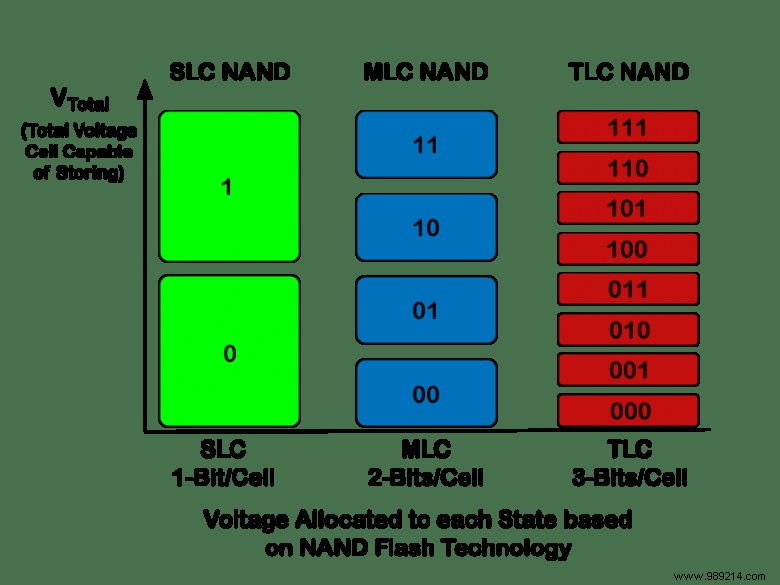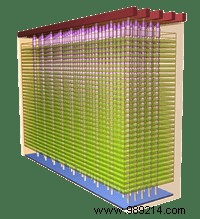Solid-state drives, or SSDs, are now common storage devices. But growing popularity rarely means growing understanding. If you're not sure how an SSD works, you're not alone. Here we explain how flash memory, aka NAND memory, actually works, what the different "levels" of NAND mean, and how to get a good deal on an SSD today.
ContentsWhat is NAND memory?How can a logic gate store information?What is SLC, MLC, TLC and QLC?What is 3D NAND?How it all fits together
NAND gates have a special property that is not shared by most types of logic gates. NAND gates can be used to create what is called a flip-flop gate. It is a circuit made up of two NAND gates wired together in a very specific way. As seen above, the output of each NAND gate is wired to the input of its partner.
This wiring allows the storage of 1s and 0s over time and without power supply. So, with the proper wiring, NAND gates can create computer memory for one bit. Assemble a bunch of NAND gates and you can store a bunch of bits. And that's what makes flash memory and, eventually, an SSD.

Flash storage is built on cells, which store bits. The most basic means of storage is a "single level cell" or SLC. These cells can be set to 0 or 1 to indicate on and off. These cells are fast and durable, but they don't offer much storage. We need to store more than one bit per cell to increase this.
This is where multi-level cells, or MLCs, come in. These cells store two bits of information in a transistor using four charge levels. For example, they can use 0v, 1v, 2v, and 3v to represent 00, 01, 10, and 11 in binary. These cells hold more data but also require more precise techniques for storage and retrieval.

Newer SSDs are built on tri-level cells, or TLCs, which allows each cell to store three bits. This requires even more precise manufacturing, increasing cost and capacity at the expense of speed and reliability.
The next step is the four-level cells, or QLCs. Although Intel and Micron have developed a process for this, we probably won't see mass adoption for years yet.

The first SSDs were made as computer processors. They were created on a two-dimensional plane, and capacity and speed were increased by shrinking the transistors that made up the chip. The more transistors you can put on a chip, the more data you can store. But unlike CPU transistors, SSD transistors can't go much lower than 15nm. This is because at this level electrons can begin to seep into nearby transistors, corrupting data.
To circumvent this limitation, manufacturers have created 3D NAND. Here the transistors are also stacked on top of each other. This three-dimensional process, sometimes referred to as V-NAND, allows up to sixty-four layers of transistors to occupy a single die. This increases the storage possibilities by an order of magnitude.
The trade-off is that 3D NAND requires extremely precise manufacturing techniques to create the hyper-precise columns of transistors. This is especially important for MLC, TLC and QLC type SSDs, which already require very precise manufacturing to function properly. But that did not prevent him from conquering the modern market.
Many factories offer 3D TLC NAND drives, but there is still a large stock of fast, moderately large, and suddenly very cheap MLC drives. If you're looking for a bargain, now is the time to buy. This is slightly older technology, but the main difference will be in storage size rather than performance. If there's a good deal on a 3D MLC NAND drive big enough for you, don't hesitate to take the plunge.
As with all things electronics, the reliability history of the manufacturer is extremely important. Cheap nameless drives can be created on older process nodes or with looser tolerances. They can also come from the scraps of more choosy manufacturers, selling you the scraps that are just functional enough. Neither are a recipe for long-term success.
The next big revolution in SSD technology will come with dramatically greater capacity at the same or similar power levels. We can expect to see these rolled out over the next few years as foundries gain experience with the techniques required for new process design.
Also learn about the differences between SSD, HDD and flash storage.
Image credit:flashdba, Cactus Technology